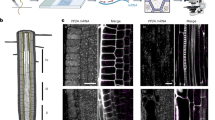Abstract
Plants are constantly adapting to ambient fluctuations through spatial and temporal transcriptional responses. Here, we implemented the latest-generation RNA imaging system and combined it with microfluidics to visualize transcriptional regulation in living Arabidopsis plants. This enabled quantitative measurements of the transcriptional activity of single loci in single cells, in real time and under changing environmental conditions. Using phosphate-responsive genes as a model, we found that active genes displayed high transcription initiation rates (one initiation event every ~3 s) and frequently clustered together in endoreplicated cells. We observed gene bursting and large allelic differences in single cells, revealing that at steady state, intrinsic noise dominated extrinsic variations. Moreover, we established that transcriptional repression triggered in roots by phosphate, a crucial macronutrient limiting plant development, occurred with unexpectedly fast kinetics (on the order of minutes) and striking heterogeneity between neighbouring cells. Access to single-cell RNA polymerase II dynamics in live plants will benefit future studies of signalling processes.
This is a preview of subscription content, access via your institution
Access options
Access Nature and 54 other Nature Portfolio journals
Get Nature+, our best-value online-access subscription
$29.99 / 30 days
cancel any time
Subscribe to this journal
Receive 12 digital issues and online access to articles
$119.00 per year
only $9.92 per issue
Buy this article
- Purchase on Springer Link
- Instant access to full article PDF
Prices may be subject to local taxes which are calculated during checkout







Similar content being viewed by others
Data availability
The genetic constructs, lines and datasets generated in the current study are available from the corresponding author upon request.
References
Lopez-Maury, L., Marguerat, S. & Bahler, J. Tuning gene expression to changing environments: from rapid responses to evolutionary adaptation. Nat. Rev. Genet. 9, 583–593 (2008).
Birnbaum, K. et al. A gene expression map of the Arabidopsis root. Science 302, 1956–1960 (2003).
Balleza, E., Kim, J. M. & Cluzel, P. Systematic characterization of maturation time of fluorescent proteins in living cells. Nat. Methods 15, 47–51 (2018).
Sorenson, R. S., Deshotel, M. J., Johnson, K., Adler, F. R. & Sieburth, L. E. Arabidopsis mRNA decay landscape arises from specialized RNA decay substrates, decapping-mediated feedback, and redundancy. Proc. Natl Acad. Sci. USA 115, E1485–E1494 (2018).
Narsai, R. et al. Genome-wide analysis of mRNA decay rates and their determinants in Arabidopsis thaliana. Plant Cell 19, 3418–3436 (2007).
Kollist, H. et al. Rapid responses to abiotic stress: priming the landscape for the signal transduction network. Trends Plant Sci. 24, 25–37 (2019).
Bertrand, E. et al. Localization of ASH1 mRNA particles in living yeast. Mol. Cell 2, 437–445 (1998).
Fusco, D. et al. Single mRNA molecules demonstrate probabilistic movement in living mammalian cells. Curr. Biol. 13, 161–167 (2003).
Boireau, S. et al. The transcriptional cycle of HIV-1 in real-time and live cells. J. Cell Biol. 179, 291–304 (2007).
Lucas, T. et al. Live imaging of bicoid-dependent transcription in Drosophila embryos. Curr. Biol. 23, 2135–2139 (2013).
Chao, J. A., Patskovsky, Y., Almo, S. C. & Singer, R. H. Structural basis for the coevolution of a viral RNA–protein complex. Nat. Struct. Mol. Biol. 15, 103–105 (2008).
Pichon, X., Lagha, M., Mueller, F. & Bertrand, E. A growing toolbox to image gene expression in single cells: sensitive approaches for demanding challenges. Mol. Cell 71, 468–480 (2018).
Tantale, K. et al. A single-molecule view of transcription reveals convoys of RNA polymerases and multi-scale bursting. Nat. Commun. 7, 12248 (2016).
Misson, J. et al. A genome-wide transcriptional analysis using Arabidopsis thaliana Affymetrix gene chips determined plant responses to phosphate deprivation. Proc. Natl Acad. Sci. USA 102, 11934–11939 (2005).
Thibaud, M. C. et al. Dissection of local and systemic transcriptional responses to phosphate starvation in Arabidopsis. Plant J. 64, 775–789 (2010).
Rubio, V. et al. A conserved MYB transcription factor involved in phosphate starvation signaling both in vascular plants and in unicellular algae. Genes Dev. 15, 2122–2133 (2001).
Bustos, R. et al. A central regulatory system largely controls transcriptional activation and repression responses to phosphate starvation in Arabidopsis. PLoS Genet. 6, e1001102 (2010).
Puga, M. I. et al. SPX1 is a phosphate-dependent inhibitor of PHOSPHATE STARVATION RESPONSE 1 in Arabidopsis. Proc. Natl Acad. Sci. USA 111, 14947–14952 (2014).
Wang, Z. et al. Rice SPX1 and SPX2 inhibit phosphate starvation responses through interacting with PHR2 in a phosphate-dependent manner. Proc. Natl Acad. Sci. USA 111, 14953–14958 (2014).
Zhu, J. et al. Two bifunctional inositol pyrophosphate kinases/phosphatases control plant phosphate homeostasis. eLife https://doi.org/10.7554/eLife.43582 (2019).
Wild, R. et al. Control of eukaryotic phosphate homeostasis by inositol polyphosphate sensor domains. Science 352, 986–990 (2016).
Grossmann, G. et al. The RootChip: an integrated microfluidic chip for plant science. Plant Cell 12, 4234–4240 (2011).
Misson, J., Thibaud, M. C., Bechtold, N., Raghothama, K. & Nussaume, L. Transcriptional regulation and functional properties of Arabidopsis Pht1;4, a high affinity transporter contributing greatly to phosphate uptake in phosphate deprived plants. Plant Mol. Biol. 55, 727–741 (2004).
Tutucci, E. et al. An improved MS2 system for accurate reporting of the mRNA life cycle. Nat. Methods 15, 81–89 (2018).
Engler, C., Gruetzner, R., Kandzia, R. & Marillonnet, S. Golden gate shuffling: a one-pot DNA shuffling method based on type IIs restriction enzymes. PLoS ONE 4, e5553 (2009).
Grefen, C. et al. A ubiquitin-10 promoter-based vector set for fluorescent protein tagging facilitates temporal stability and native protein distribution in transient and stable expression studies. Plant J. 64, 355–365 (2010).
Duncan, S., Olsson, T. S. G., Hartley, M., Dean, C. & Rosa, S. A method for detecting single mRNA molecules in Arabidopsis thaliana. Plant Methods 12, 13 (2016).
Duan, K. et al. Characterization of a sub-family of Arabidopsis genes with the SPX domain reveals their diverse functions in plant tolerance to phosphorus starvation. Plant J. 54, 965–975 (2008).
Bhosale, R. et al. A spatiotemporal DNA endoploidy map of the Arabidopsis root reveals roles for the endocycle in root development and stress adaptation. Plant Cell 30, 2330–2351 (2018).
Levsky, J. M., Shenoy, S. M., Pezo, R. C. & Singer, R. H. Single-cell gene expression profiling. Science 297, 836–840 (2002).
Femino, A. M., Fay, F. S., Fogarty, K. & Singer, R. H. Visualization of single RNA transcripts in situ. Science 280, 585–590 (1998).
Zhu, J., Liu, M., Liu, X. & Dong, Z. RNA polymerase II activity revealed by GRO-seq and pNET-seq in Arabidopsis. Nat. Plants 4, 1112–1123 (2018).
Hetzel, J., Duttke, S. H., Benner, C. & Chory, J. Nascent RNA sequencing reveals distinct features in plant transcription. Proc. Natl Acad. Sci. USA 113, 12316–12321 (2016).
Furlong, E. E. M. & Levine, M. Developmental enhancers and chromosome topology. Science 361, 1341–1345 (2018).
Garcia, H. G., Tikhonov, M., Lin, A. & Gregor, T. Quantitative imaging of transcription in living Drosophila embryos links polymerase activity to patterning. Curr. Biol. 23, 2140–2145 (2013).
Alamos, S., Reimer, A., Niyogi, K. K. & Garcia, H. G. Quantitative imaging of RNA polymerase II activity in plants reveals the single-cell basis of tissue-wide transcriptional dynamics. Nat. Plants https://doi.org/10.1038/s41477-021-00976-0 (2021).
Elowitz, M. B., Levine, A. J., Siggia, E. D. & Swain, P. S. Stochastic gene expression in a single cell. Science 297, 1183–1186 (2002).
Guichard, M., Bertran Garcia de Olalla, E., Stanley, C. E. & Grossmann, G. Microfluidic systems for plant root imaging. Methods Cell. Biol. 160, 381–404 (2020).
Bayle, V. et al. Arabidopsis thaliana high-affinity phosphate transporters exhibit multiple levels of posttranslational regulation. Plant Cell 23, 1523–1535 (2011).
Pichon, X. et al. Visualization of single endogenous polysomes reveals the dynamics of translation in live human cells. J. Cell Biol. 214, 769–781 (2016).
Pena, E. J. & Heinlein, M. RNA transport during TMV cell-to-cell movement. Front. Plant Sci. 3, 193 (2012).
Kanno, S. et al. Development of real-time radioisotope imaging systems for plant nutrient uptake studies. Phil. Trans. R. Soc. B 367, 1501–1508 (2012).
Kanno, S. et al. A novel role for the root cap in phosphate uptake and homeostasis. eLife 5, e14577 (2016).
Schubert, V., Berr, A. & Meister, A. Interphase chromatin organisation in Arabidopsis nuclei: constraints versus randomness. Chromosoma 121, 369–387 (2012).
Hanchi, M. et al. The phosphate fast-responsive genes PECP1 and PPsPase1 affect phosphocholine and phosphoethanolamine content. Plant Physiol. 176, 2943–2962 (2018).
Gutierrez, R. A., Ewing, R. M., Cherry, J. M. & Green, P. J. Identification of unstable transcripts in Arabidopsis by cDNA microarray analysis: rapid decay is associated with a group of touch- and specific clock-controlled genes. Proc. Natl Acad. Sci. USA 99, 11513–11518 (2002).
Sarrobert, C. et al. Identification of an Arabidopsis thaliana mutant accumulating threonine resulting from mutation in a new dihydrodipicolinate synthase gene. Plant J. 24, 357–367 (2000).
Secco, D. et al. Stress induced gene expression drives transient DNA methylation changes at adjacent repetitive elements. eLife https://doi.org/10.7554/eLife.09343 (2015).
Godon, C. et al. Under phosphate starvation conditions, Fe and Al trigger accumulation of the transcription factor STOP1 in the nucleus of Arabidopsis root cells. Plant J. 99, 937–949 (2019).
Pandolfini, L. et al. METTL1 promotes let-7 microRNA processing via m7G methylation. Mol. Cell 74, 1278–1290 (2019).
Harrison, S. J. et al. A rapid and robust method of identifying transformed Arabidopsis thaliana seedlings following floral dip transformation. Plant Methods 2, 19 (2006).
Tsanov, N. et al. smiFISH and FISH-quant—a flexible single RNA detection approach with super-resolution capability. Nucleic Acids Res. 44, e165 (2016).
Ouyang, W., Mueller, F., Hjelmare, M., Lundberg, E. & Zimmer, C. ImJoy: an open-source computational platform for the deep learning era. Nat. Methods 16, 1199–1200 (2019).
Mueller, F. et al. FISH-quant: automatic counting of transcripts in 3D FISH images. Nat. Methods 10, 277–278 (2013).
Dufrene, Y. F., Martinez-Martin, D., Medalsy, I., Alsteens, D. & Muller, D. J. Multiparametric imaging of biological systems by force-distance curve-based AFM. Nat. Methods 10, 847–854 (2013).
Acknowledgements
S.H. was supported by a PhD fellowship from the CEA and PACA region, the ANR Reglisse 13-ADAP-008 fellowship and the CEA DRF impulsion programme, and the FOSSI project supported E.M., L.C., L.N., M.-C.T. and P.D. Additional grant support was received by H.J. from CEA-Enhanced Eurotalent and ANR PhlowZ 19-CE-13-0007. We thank the Heliobiotech platform for access to their RT–qPCR machine. We thank E. Basyuk for her help with the MS2 plasmids, and we thank L. Laplaze and G. Desbrosses for providing access to the growth chambers of IRD and Montpellier University. We thank O. Radulescu for his help with calculating total, extrinsic and intrinsic noise for an undefined number of alleles; T. Desnos and C. Mercier for their assistance on figure drawing; and S. Kanno and H. Garcia for critical reading of the manuscript. We thank J. Escudier for the synthesis of the SPX1 set of fluorescent probes. We acknowledge the MRI imaging facility (belonging to the National Infrastructure France-BioImaging supported by the French National Research Agency, ANR-10-INBS-04) and the ZoOM platform (supported by the Région Provence Alpes Côte d’Azur, the Conseil General of Bouches du Rhône, the French Ministry of Research, the Centre National de la Recherche Scientifique and the Commissariat à l’Energie Atomique et aux Energies Alternatives).
Author information
Authors and Affiliations
Contributions
E.B. provided the MS2 and MCP original constructs, and L.N. conceived the experiments. L.C., S.H. and P.D. performed all the experiments under the supervision of L.N. for the physiological part and E.B. for cell biology. The RNA-seq data were produced by D.S. and J.W. and analysed by L.N., L.C. M.-C.T. and E.M. The luminescence experiments were performed by N.P. under the supervision of H.J. H.J. also implemented the microfluidic technique in the SAVE team. R.M. performed the experiments for cap and polyA tail detection, F.M. provided assistance for image analysis and computation and O.F. took part in the spinning disk and mosaic acquisition experiments. The manuscript was written by L.N. and E.B. with help from S.H., P.D. and L.C.
Corresponding authors
Ethics declarations
Competing interests
The authors declare no competing interests.
Additional information
Peer review information Nature Plants thanks Zhicheng Dong and the other, anonymous, reviewer(s) for their contribution to the peer review of this work.
Publisher’s note Springer Nature remains neutral with regard to jurisdictional claims in published maps and institutional affiliations.
Supplementary information
Supplementary Information
Supplementary Figs. 1–12 with legends and Tables 1–3 with legends.
Supplementary Video 1
Bursting activity of the pSPX1::MS2×128 reporter. Video of root cap cells of the Arabidopsis S line expressing pSPX1::MS2×128 and MCP–GFP and continuously grown without Pi. MIPs (xy and xz) are from a time-lapse video recorded in 3D (44 z planes). Time (in min) is indicated.
Supplementary Video 2
Putative release of single RNAs in the nucleoplasm when promoter activity stochastically turns off when a burst ends. Video of root cap cells of the Arabidopsis S line expressing pSPX1::MS2×128 and MCP–GFP and continuously grown without Pi. MIPs (xy and xz) are from a time-lapse video recorded in 3D (44 z planes). Time (in min) is indicated.
Supplementary Video 3
Transcriptional repression of the pSPX1::MS2×128 reporter triggered by Pi resupply. Video of root cells of the Arabidopsis S line transformed with pSPX1::MS2×128 and MCP–GFP, after receiving a Pi-rich solution at time t = 0 min. MIP from a time-lapse video recorded in 3D (200 z planes). Acquisitions lasted 39 min.
Supplementary Video 4
Transcriptional repression of the pSPX1::MS2×128 reporter triggered by Pi resupply. Zoom on a few cells cropped from Supplementary Video 3.
Supplementary Video 5
Transcriptional repression of the pSPX1::MS2×128 reporter triggered by Pi resupply. Another video of root cells of the Arabidopsis S line transformed with pSPX1::MS2×128 and MCP–GFP, after receiving a Pi-rich solution at time t = 0 min. MIP from a time-lapse video recorded in 3D (200 z planes). Acquisitions lasted 54 min.
Supplementary Video 6
Transcriptional repression of the pSPX1::MS2×128 reporter triggered by Pi resupply. Magnification deriving from Supplementary Video 5.
Supplementary Video 7
Transcriptional repression of the pSPX1::MS2×128 reporter triggered by Pi resupply. Magnification deriving from Supplementary Video 5.
Supplementary Video 8
Transcriptional repression of the pSPX1::MS2×128 reporter triggered by Pi resupply. Video of root cells of the Arabidopsis J line transformed with pSPX1::MS2×128 and MCP–GFP, after receiving a Pi-rich solution at time t = 0 min. MIP from a time-lapse video recorded in 3D (200 z planes). Acquisitions lasted 54 min.
Rights and permissions
About this article
Cite this article
Hani, S., Cuyas, L., David, P. et al. Live single-cell transcriptional dynamics via RNA labelling during the phosphate response in plants. Nat. Plants 7, 1050–1064 (2021). https://doi.org/10.1038/s41477-021-00981-3
Received:
Accepted:
Published:
Issue Date:
DOI: https://doi.org/10.1038/s41477-021-00981-3
This article is cited by
-
Identification and interest of molecular markers to monitor plant Pi status
BMC Plant Biology (2023)
-
CRISPR-dCas13-tracing reveals transcriptional memory and limited mRNA export in developing zebrafish embryos
Genome Biology (2023)
-
Unraveling Metabolic Profile of Wheat Plants Subjected to Different Phosphate Regimes
Journal of Soil Science and Plant Nutrition (2023)
-
Comparative transcriptome analysis reveals a rapid response to phosphorus deficiency in a phosphorus-efficient rice genotype
Scientific Reports (2022)
-
Noise reduction by upstream open reading frames
Nature Plants (2022)



